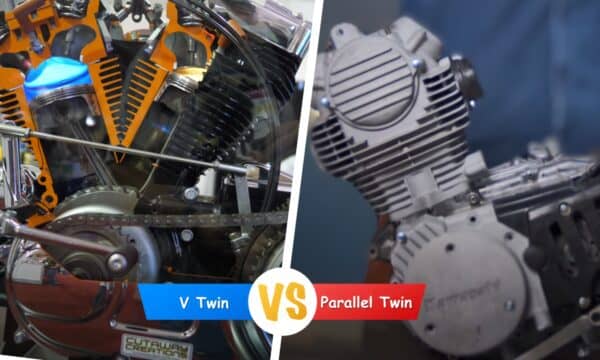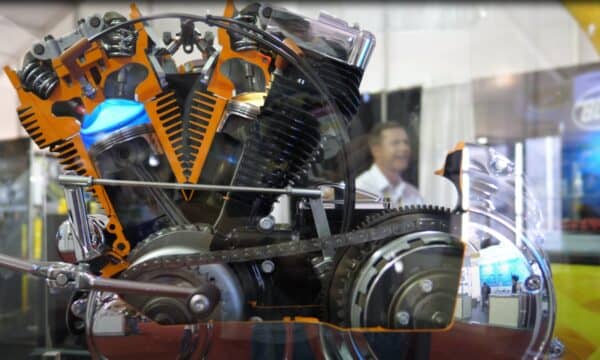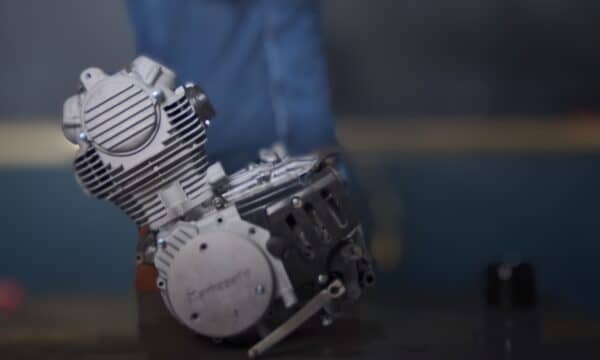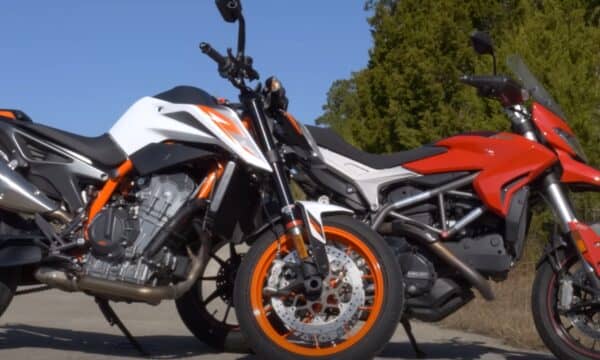If you want to choose a bike between a V twin engine and a Parallel twin-engine and do not know which would be the best for you then don’t worry.
Because it is very difficult to understand the clear differences between V twin and Parallel-twin engine.

But today in this guide article I will explore the differences between both of these engines and try to make it easier for you to choose the best option for yourself.
Let’s dive in!
What is a V Twin Engine?
A V-twin engine is a two-cylinder internal combustion engine, cylinders are arranged in a V configuration.

This type of engine is most commonly found in motorcycles; the V-twin design is favored for its compact size, unique sound, and the ability to produce strong low-to-mid range torque.
The angle between the two cylinders can be different, for example, the 45-degree angle in Harley-Davidson motorcycles and the 90-degree angle in Ducati motorcycles.
The V-twin appearance and performance characteristics have made it an iconic engine design in the motorcycling world.
Pros
- Perfect balancing
- Air cooling
- Wide application
- Legroom space
- Lightweight
- Have two cylinders
- Various variations
- Great torque
- Increased speed
- It makes your bike unique
Cons
- Low horsepower
- Low fuel economy
- Uneven firing
What is a Parallel Twin Engine?
A parallel twin engine is mostly found in motorcycles, and it is a two-cylinder internal combustion engine where the cylinders are arranged side by side in parallel.

This engine has been popular for its simplicity and cost-effectiveness. The two pistons typically move together; both reach the top dead center and bottom dead center simultaneously.
This design led to a balanced engine with fewer vibrations, especially when compared to single-cylinder engines.
Over the years, parallel twin engines have been utilized in various motorcycle models, offering a blend of performance and efficiency.
Pros
- Compact and lightweight
- Smooth power delivery
- Fuel efficiency
- A single carburetor can be used for both cylinders
- Cost-effective
- Balanced vibration
Cons
- Lack of low-end torque
- Less distinctive sound
Which one is best between the V Twin and Parallel Twin?
Here are some of the comparisons between the V Twin and Parallel-twin.

Packaging
The design and layout of an engine can greatly influence the overall packaging of a motorcycle, affecting its weight distribution, balance, and even aesthetics.
V-Twin
The V-twin engine configuration is characterized by its two cylinders arranged in a V-shape. This design is compact in width, which can lead to a narrower motorcycle profile.
The V-twin’s unique layout also allows for a lower center of gravity, which is beneficial for handling and stability. However, the V-twin can be longer front-to-back, which might influence the bike’s wheelbase and overall length.
Parallel Twin
The parallel-twin engine has its two cylinders arranged side by side. This design is typically shorter in length compared to the V-twin.
Which can lead to a shorter wheelbase and potentially more agile handling. However, the parallel twin is wider, which might make the motorcycle feel bulkier in certain scenarios, especially in tight traffic.
Power and Sound
The engine configuration can also influence the power delivery and the characteristic sound of the motorcycle.
V-Twin
V-twins are known for their torque-rich power delivery, especially at lower RPMs.
It makes them excellent for city riding and cruising, where immediate torque is often more valuable than top-end power. The V-twin also has a distinct and throaty exhaust note, which many riders find appealing.
Parallel Twin
Parallel twins tend to have a smoother and more linear power delivery, often with a stronger mid-range and top-end compared to V-twins.
It can make them more versatile across a range of riding conditions. Sound-wise, parallel twins have a more even and less thumpy exhaust note. Which might be perceived as less characterful than the V-twin but can be more refined.
Cost
The cost of manufacturing, maintenance, and overall ownership can vary between the two engine configurations.
V-Twin
V-twin engines, due to their unique configuration, might be more expensive to manufacture and maintain.
The angled arrangement of the cylinders can make certain components less accessible, potentially increasing labor costs for repairs.
Especially V-twins found in premium brands, which come with a higher price tag.
Parallel Twin
Parallel twin engines are often simpler in design and can be more cost-effective to produce.
It can translate to a lower purchase price for motorcycles equipped with parallel twins. Maintenance might also be more straightforward and cost-effective due to the side-by-side arrangement of the cylinders.
Our suggestions
Choosing between a V-twin and a parallel twin depends on your preferences and intended use.
If you value torque-rich performance, and a distinct sound, and are willing to pay a premium, the V-twin might be the better choice.
On the other hand, if you’re looking for versatility, smoother power delivery, and potentially lower costs, you must look for the parallel twin.
FAQ
What is the difference between a parallel twin and a V-twin cylinder?
A parallel twin has two cylinders side by side with parallel axes, while a V-twin positions two cylinders in a V-shape, typically at angles like 45°, 60°, or 90°.
Is parallel twin better than V-twin?
Whether a parallel twin is “better” than a V-twin depends on the application and preference.
Parallel twins often offer smoother operation and are compact, while V-twins provide more torque and a distinct exhaust note. Each has its advantages and character suits different motorcycle styles and preferences.
What are the benefits of V-twin engines?
V-twin engines offer strong low-end torque, a distinct exhaust note, and a narrow profile, which can benefit motorcycle handling.
Their design also contributes to a bike’s aesthetic appeal and character, favored by many cruiser and custom motorcycle enthusiasts.
Why do V-twins sound so good?
V-twins have a unique firing order and longer exhaust pulses, producing a deep, rhythmic rumble.
This distinct sound resonates with many enthusiasts, evoking a sense of raw power and mechanical character.
Wrapping UP
V-twin and parallel twin engines offer distinct advantages. The V-twin delivers a characteristic deep rumble and strong low-end torque, often preferred for cruising and relaxed riding.
On the other hand, parallel twins tend to be more compact, balanced, and versatile, making them suitable for various motorcycles, from sporty to commuter bikes.
But the choice between them boils down to your preference, intended use, and the desired riding experience.
You may also love to read!
Milwaukee 107 Vs 114 [Which is the Best]

Ahtsham Younas is a passionate blogger and content writer. He loves to ride motorcycles and learn the mechanical process behind the motorcycles.
He has been writing articles in the motorcycle industry since 2019 and has learned many things about motorbike niches.


